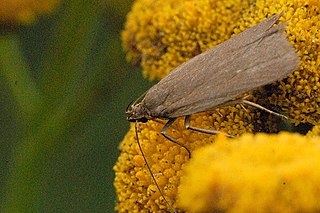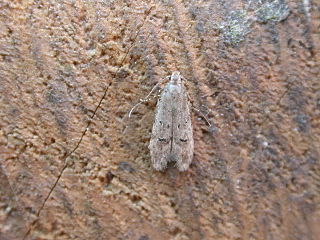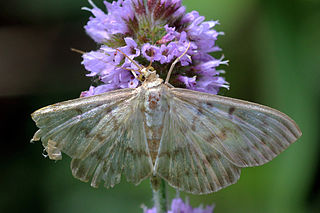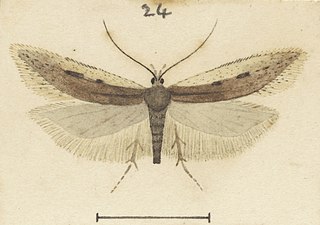
The Old Grey Whistle Test was a British television music show. The show was devised by BBC producer Rowan Ayers, commissioned by David Attenborough and aired on BBC2 from 1971 to 1988. It took over the BBC2 late-night slot from Disco 2, which ran between September 1970 and July 1971, while continuing to feature non-chart music. The original producer, involved in an executive capacity throughout the show's entire history, was Michael Appleton.

The mottled pug is a moth of the family Geometridae. The species was first described by Jacob Hübner in 1813. It is found across the Palearctic region apart from around the Mediterranean Sea. It is common in the British Isles apart from Scotland where it is rather local.

The lilac chaser is a visual illusion, also known as the Pac-Man illusion. It consists of 12 lilac, blurred discs arranged in a circle, around a small black, central cross on a grey background. One of the discs disappears briefly, then the next, and the next, and so on, in a clockwise direction. When one stares at the cross for at least 30 seconds, one sees three different illusions:
- A gap running around the circle of lilac discs;
- A green disc running around the circle of lilac discs in place of the gap;
- The green disc running around on the grey background, with the lilac discs having disappeared in sequence.
Coniogyra is a genus of moth in the family Gelechiidae. It contains the species Coniogyra dilucescens, which is found in Zimbabwe.

Ecliptopera silaceata, the small phoenix, is a moth of the family Geometridae. The species was first described by Michael Denis and Ignaz Schiffermüller in 1775.

Pyrausta despicata, the straw-barred pearl, is a species of moth of the family Crambidae. It was described by Giovanni Antonio Scopoli in his 1763 Entomologia Carniolica.

Anania fuscalis is a species of moth of the family Crambidae. It is found in Europe.

Scrobipalpa acuminatella is a moth of the family Gelechiidae. It is found in most of Europe, as well as Turkey, southern Siberia, Central Asia and China (Anhui). It was recently reported from Canada, with records from Ontario and Québec.

Acleris rhombana, the rhomboid tortrix, is a moth of the family Tortricidae. It is found in the Palearctic realm, from Europe to the Caucasus, Armenia, and Turkmenistan.

Lichenaula lichenea is a species of moth of the family Xyloryctidae. It is known in Australia from the Australian Capital Territory, New South Wales and Queensland.

Teleiodes vulgella is a moth of the family Gelechiidae. It is known from most of Europe, east to the southern Ural and the Volga region.

Carpatolechia notatella, the sallow-leaf groundling, is a moth of the family Gelechiidae. It is found in most of Europe and Turkey.
Dichomeris ampycota is a moth of the family Gelechiidae. It was described by Edward Meyrick in 1913. It is known from Sri Lanka.
Dichomeris antisticta is a moth of the family Gelechiidae. It was described by Edward Meyrick in 1929. It is known from southern India.

Patania ruralis, the mother of pearl moth, is a species of moth of the family Crambidae. It was described by Giovanni Antonio Scopoli in 1763. It is found in Europe.
Garrha metriopis is a moth in the family Oecophoridae. It was described by Edward Meyrick in 1887. It is found in Australia, where it has been recorded from New South Wales.
Dichomeris pleuropa is a moth in the family Gelechiidae. It was described by Edward Meyrick in 1921. It is found in South Africa.

Kiwaia aerobatis is a moth in the family Gelechiidae. It was described by Edward Meyrick in 1924. It is found in New Zealand.
Anacampsis anisogramma is a moth of the family Gelechiidae. It was described by Edward Meyrick in 1927. It is found in China (Shanghai).
Anacampsis comparanda is a moth of the family Gelechiidae. It was described by Edward Meyrick in 1929. It is found in North America, where it has been recorded from Arizona and Texas.












